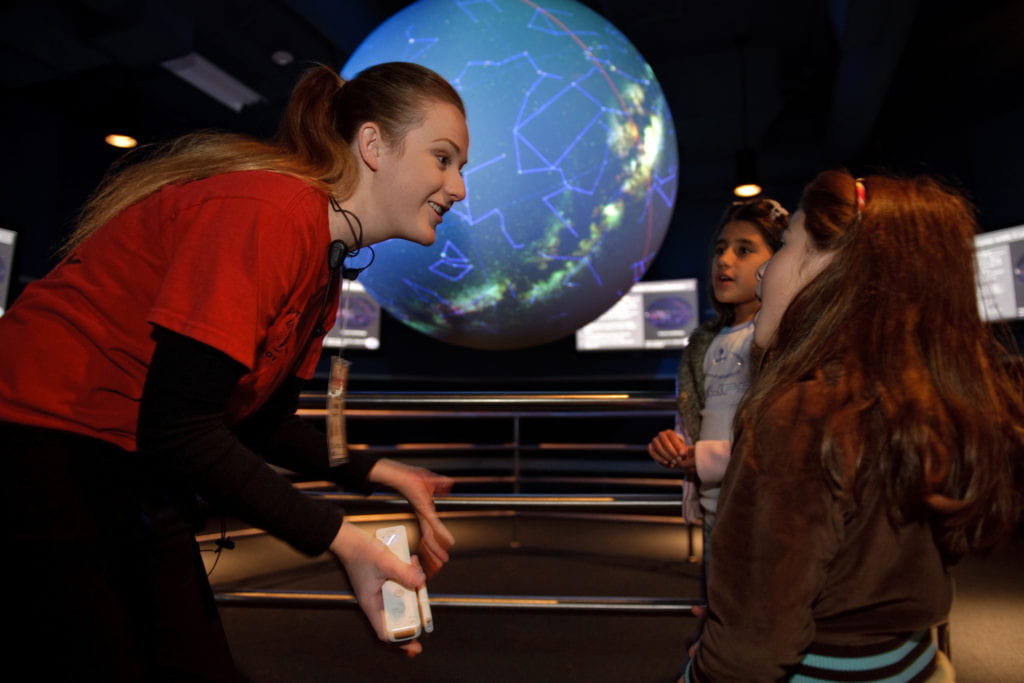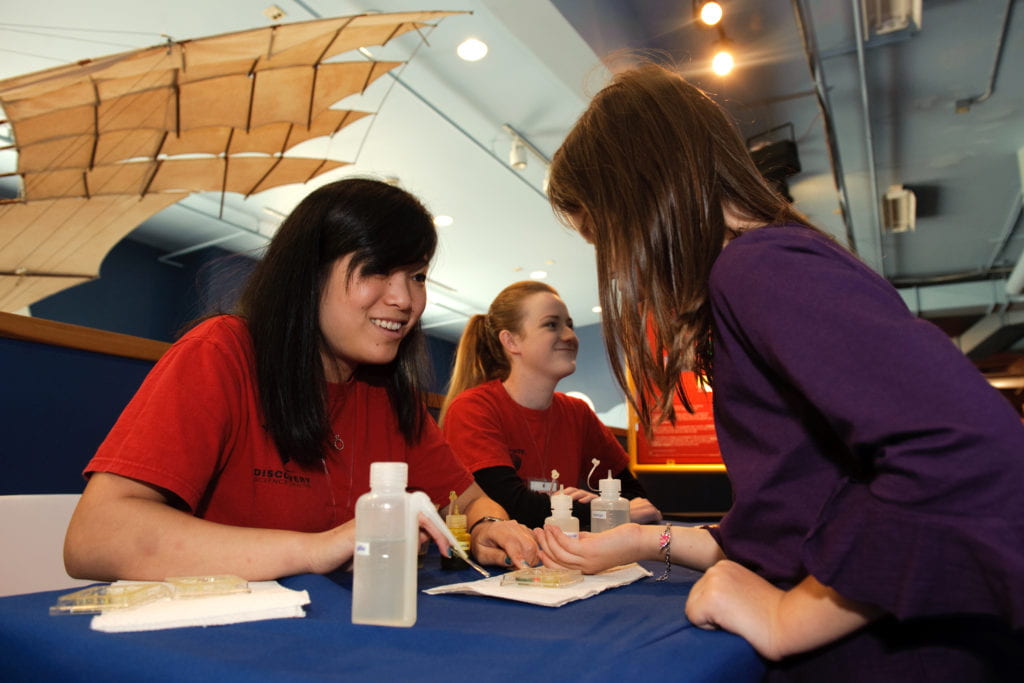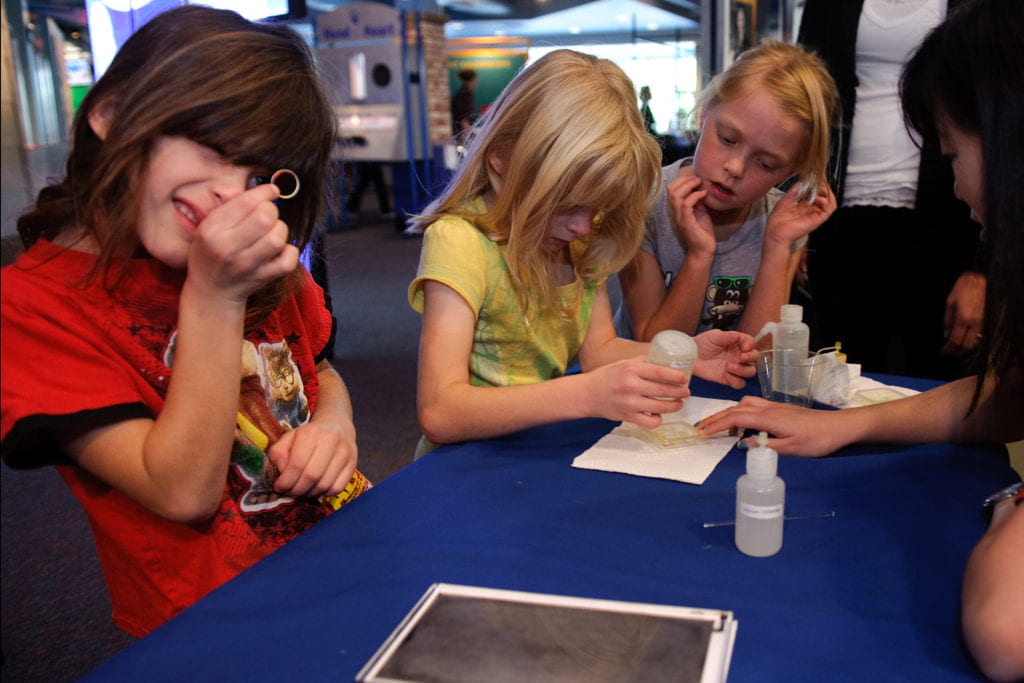Making science come alive
UCI students educate, entertain children visiting Santa Ana museum.
Amid the cheerful cacophony of shrieking, hurtling children at the Discovery Science Center in Santa Ana, two young women in red T-shirts work quietly with a trio of 7-year-old girls on a school holiday.
“Today we’re doing an experiment. Let’s start by adding 10 drops of the vinegar,” says UC Irvine graduate student Crystal Ho, 21. “Do you want to guess what color this might turn?”
Reese Hallo eyes the beaker of universal indictor solution – a compound of chemicals that allows acids and bases to be easily identified – and proclaims: “Green!”
Seconds later, the liquid turns red. “Red?” says the girl disbelievingly.
“This tells us that our vinegar is an acid, and it’s going to turn red,” says Ho, who’s studying for a master’s in math with a teaching credential. Her chemistry lesson begins to unfold. “If we add a lot of this one – this base called sodium carbonate – it turns blue.”
She instructs Reese and her best friend, Frances Tomlin, both of Santa Monica, to add 10 drops of the substance, a stronger version of baking powder.
“Okay, if you stir that up, what do you get?” Ho asks.
“Blue! Yes, I knew it,” Reese says happily.
Nearby, her twin sister, Sami, squints at the metal ring encircling a brightly colored disc, trying to figure out what makes tiny iron specks adhere to it.
“What’s around the plastic? What’s on the ring?” asks Lauren Henry, 21, a UCI Earth system science major who graduated this summer.
“Metal!” Sami says.
“That’s right, and the magnets are attracted to it,” Henry explains. “It’s called the magnetic force. So now answer this question: Why do magnets stick to your refrigerator at home?”
“Because of the magnetic force,” Sami responds.
It’s all part of the plan – the lesson plan, that is. Since February, 18 UCI science and math students have been helping to educate the nearly half a million schoolchildren who visit the bustling Orange County museum each year, thanks to a Chemistry at the Space-Time Limit outreach grant from the National Science Foundation.
“I love this program because young children of all backgrounds and future scientists learn from each other in a fun and informative way,” says UCI CaSTL program representative Petra Eshuis-van’t Slot. “Children have the special ability to wonder. They ask great questions, and I love to see that spark in their eyes. If that positive experience regarding chemistry stays with them, they’ll come back to it.”
She and the Discovery Science Center’s education manager design hands-on demonstrations to align with California science content standards. Field trips are coordinated monthly by grade: November is focused on teaching second-graders about magnetic fields, for instance, while December is dedicated to first-graders learning about liquids, solids and gases.
“We’re a bridge between the university and the museum,” says Henry, who adds that the job has prompted her to apply to UCI’s master of arts in teaching program – with the new goal of becoming a junior high math teacher.
The students receive $12 an hour, and they earn it. In high-energy shifts, they shuttle between demo tables set up in the main hall and the Planetary Research Station room.
Inside the latter is a giant globe dangling from the ceiling upon which more than 500 computer-generated images can be displayed, showing everything from the path of this spring’s oil spill across the Gulf of Mexico to Jupiter’s highest mountain.
Henry says children sometimes interrupt her prepared planetary presentation with comments such as “I’ve been to Jupiter” and begin relating their own imaginary space adventures.
“The older the better for learning science – the younger the funnier,” she says.
Today is no exception.
“I want be a scientist when I grow up,” says Stephanie Ray, 6, of San Clemente. “I have a question: How do you make space ice cream?”
Henry is flummoxed until she realizes the little girl is talking about an item for sale in the lobby.
“I think they remove all the water, and then you can just eat the powder,” she says, deftly converting the query into a teachable moment.
Parents and museum staff alike praise the UCI students’ work.
“It’s a great program,” says Karen Hallo, mother of budding scientists Reese and Sami. “It provides the hands-on part of learning.”


